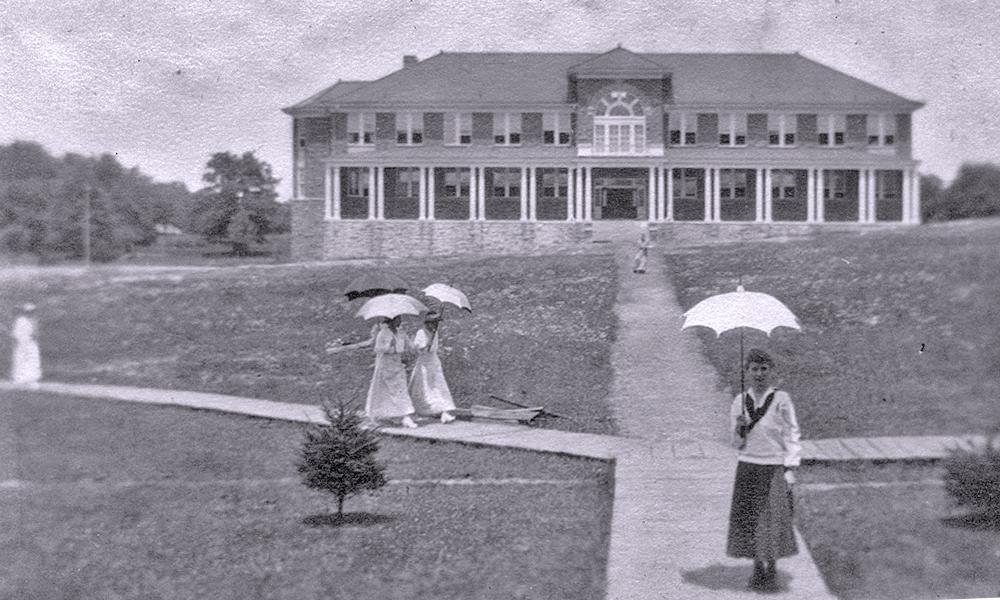Committee releases digital version of Quad History Tour
JMU in the Community
SUMMARY: The self-guided tour is intended to reflect on the campus as an evolving, commemorative landscape and to highlight the contributions of people whose experiences have not traditionally been part of the institutional narrative.
Building on the success of a walking tour that debuted in 2018, the Campus History Committee has released a digital version of its Quad History Tour meant to provide a more accurate, inclusive history of JMU’s original Bluestone Area.
The self-guided tour, developed in partnership with University Marketing and Branding, is intended to reflect on the campus as an evolving, commemorative landscape and to highlight the contributions of people whose experiences have not traditionally been part of the institutional narrative.
Committee chair Meg Mulrooney, senior associate vice provost and professor of History, said the tour is largely the result of her own extensive research, which began in 2006.
“I wanted to really understand this place. I wanted to understand its distinct culture. And that led me backward in time,” Mulrooney said. “Engaging with the past helps make those stories come alive and helps you remember it particularly.”
 |
| The building that would become Spotswood Hall opened on the Quad in 1917 as Dormitory No. 3. It remains a freshman residence hall to this day. |
The tour uncovers the rich history of academic and residential halls on the Quad, along with stories of individuals who contributed to the university’s evolution from a teachers college for white, mostly Southern, women to a fully comprehensive university. Some of these individuals were honored in the renaming of three buildings on the Quad in 2021.

Karen Risch Mott, director of annual giving and a member of the Campus History Committee, admires the historical throughline of Black history that the tour provides.
“It’s really easy for white folks like me to forget that Black folks have been on this campus since it began,” Risch Mott said, adding, “I’m particularly touched by the story of Walker Lee, who was probably the first Black employee of the university.”
|
"One of [the reasons the tour is important] is to help to tell stories of people who have backgrounds similar to our students. That helps create a sense of belonging. It shows that we at the university value the contributions of people — all kinds of people." — Karen Risch Mott, Campus History Committee member |
The oldest academic building on the Quad, Gabbin Hall, is named for Joanne V. Gabbin — who was responsible for bringing Risch Mott to JMU as a member of the Furious Flower Poetry Center staff — and her husband, Alexander Gabbin.
Mulrooney highlighted the tour’s remarkable story of Yuri Nemoto (’43), who helped blaze a trail for future generations of Asian American students at Madison.
“I think these are important lessons for our students today, of these pioneering women who came first to get certificates and job training, but then later to get bachelor's degrees in the 1930s and 1940s. And right on up to the present, moving into the workforce — that’s part of our history,” Mulrooney said.
Risch Mott believes anyone who takes the tour will see themselves represented regardless of age, race or gender.
“One of [the reasons the tour is important] is to help to tell stories of people who have backgrounds similar to our students,” she said. “That helps create a sense of belonging. It shows that we at the university value the contributions of people — all kinds of people.”

Prior to the Quad History tour, accounts of Madison’s early history relied heavily on a book written in 1959 by history professor Raymond Dingledine Jr. called Madison College: The First Fifty Years.
Although the publication had some valuable information, Mulrooney said, many things were left out or simply wrong. For example, it made no mention of the landmark 1954 Supreme Court decision in Brown v. Board of Education or its impact.
“[Dingledine] was commissioned to write that book,” Mulrooney said. “It was a 50th anniversary book. So it was intended to be celebratory and not really analytical.”
Mulrooney called the Quad History Tour “a good example of a lot of new information that had come to light, but also the fact that the way we would think about the history of a formerly segregated all-women’s college had changed.”
 |
| In the institution’s early years, female students were not allowed to be in the presence of young men without a chaperone, so legend has it that many couples would hide behind “kissing rock,” out of sight of administrators. |
In addtion, Risch Mott hopes the tour will serve to debunk some popular myths surrounding the Quad, such as the “Kissing Rock” and murders that supposedly took place in the underground tunnels. “That’s not real stuff,” she said.
The beauty of the digital Quad History Tour is that it can be completed from anywhere. “You could do it at home in your pj’s, or you could also come to campus with your phone and walk around,” Mulrooney said.
Either way, the committee urges people to take time and reflect on what they learn, because it may be different from what they know about the institution.
Mulrooney and Risch Mott recognize that the university has a more expansive past that goes beyond the Quad and beyond what the committee can capture in a single tour. Rather, the Quad History Tour is the beginning of an effort to expand public knowledge about Madison’s rich, complex history.
The committee welcomes feedback on what tours the JMU community would like to see next.
